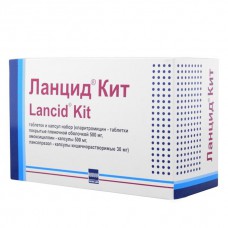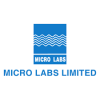Expiration date: 08/2025
COMPOSITION
tablets and capsules set:
1 blister included:
tablets clarithromycin, sir. film coating, 500 mg (2 PCs. ),
capsules amoxicillin 500 mg (4 PCs.),
capsules lansoprazole enteric-soluble 30 mg (2 PCs.);
7 blisters in a package
Indications for use:
Gastric and duodenal ulcer (treatment and eradication therapy of Helicobacter pylori infection).
Contraindications
Hypersensitivity to any component of the preparation (the main substance and/or auxiliary components), to macrolides, penicillins, cephalosporins, carbapenems; concomitant administration of clarithromycin with the following drugs: astemizole, cisapride, pimozide, terfenadine; with sporyna alkaloids, for example, ergotamine, dihydroergotamine; with midazolam for oral administration; with inhibitors HMG-COA reductase (statins), which are largely metabolized by CYP3A4 isoenzyme (lovastatin, simvastatin), due to the increased risk of myopathy, including rhabdomyolysis; with colchicine in patients with impaired liver and kidney function; patients with a history of prolonged Qt interval, ventricular arrhythmia or ventricular tachycardia type "pirouette" ; patients with hypokalemia (risk of lengthening THE Qt interval); patients with severe hepatic insufficiency occurring simultaneously with renal insufficiency; patients with cholestatic jaundice/hepatitis in the anamnesis, developed in the application of clitromycin; porphyria; during breastfeeding and pregnancy; patients with atopic dermatitis, bronchial asthma, pollinosis, infectious mononucleosis, lymphocytic leukemia, liver failure, diseases of the gastrointestinal tract (especially colitis associated with the use of antibiotics), children under 18 years of age, in the presence of sucrose/isomaltase deficiency, fructose intolerance, glucose-galactose malabsorption.
Pharmacodynamics:
Triple therapy, including lansoprazole, clarithromycin and amoxicillin, allows achieving a high percentage of Helicobacter pylori eradication (85-94%).
Lansoprazole
is a specific inhibitor of the proton pump (H7K+-ATP-Aza); metabolized in the parietal cells of the stomach to the active sulfonamide derivatives, which inactivate N+/K+-ATP-Aza. Blocks the final stage of secretion of hydrochloric acid, reducing basal and stimulated secretion, regardless of the nature of the stimulus. With high lipophilicity, easily penetrates into the parietal cells of the stomach, concentrates in them and has a cytoprotective effect, increasing oxygenation of the gastric mucosa and increasing the secretion of bicarbonate.
Clarithromycin
- antibiotic from the group of macrolides, a semi-synthetic derivative of erythromycin A. Has antimicrobial action, which is associated with the suppression of protein synthesis by interacting with 50S ribosomal subunit of microbial cells. Effective against large number of gram-positive, gram-negative aerobic and anaerobic bacteria, including N. p?lori. The metabolite — 14-hydroxyclarithromycin — formed in the body also has a pronounced antimicrobial activity.
Amoxicillin
- semi-synthetic penicillin, has a bactericidal effect, has a wide range of effects. Antimicrobial action is due to inhibition of synthesis of peptidoglycan (base polymer of the cell wall) during the period of division and growth. Has potent activity against N. p?lori. H. Resistance pulori to amoxicillin is rare.
Combination of amoxicillin and clarithromycin
has potentiated antimicrobial effect against N. p?lori.
Pharmacokinetics:
All three drugs included in Lance Keith, have good absorption when taken orally.
Lansoprazole.
Absorption-high, bioavailability is 80-90%; eating reduces absorption and bioavailability (50%), but the inhibitory effect on gastric secretion remains the same, regardless of the meal. Time to reach maximum concentration (Tstah) after oral administration 30 mg - 1,5-2,0 hours.Duration of action - more than 24 hours. The elimination half-life (T1/2) is 1-2 hours. Excreted in the form of lansoprazole sulfone and hydroxybenzotriazole with bile (2/3), kidney - 14-23 %.
Clarithromycin
quickly absorbed from the digestive tract. Absolute bioavailability of clarithromycin 250 mg is approximately 50%. Eating slightly slows down the beginning of the absorption of clarithromycin. When taking on an empty stomach, Cmax in serum is achieved within 2 hours after oral administration. T1/2 is 3-4 hours clarithromycin Clarithromycin is widely distributed in the body. The concentration of clarithromycin in tissues exceeds that in serum. Protein binding ranges from 42 to 70%. It is excreted by kidneys and with feces (20-30% — in unchanged form, the rest — in the form of metabolites). Simultaneous administration of clarithromycin and omeprazole improves the pharmacokinetic properties of clarithromycin: the average value of Cmax increases by 10%, the minimum concentration — by 15% compared with the same indicators for monotherapy clarithromycin.
Amoxicillin
quickly absorbed from the digestive tract. Eating does not affect the absorption of amoxicillin. The bioavailability of amoxicillin is 75-90%. The drug is quickly distributed in the body tissues. T1 / 2 is 1-1.5 h. protein Binding — 20%. About 60% of the dose is excreted in the urine unchanged, a small amount — with feces.
Side effect:
Clarithromycin
Infectious and parasitic diseases: infrequently-candidiasis, gastroenteritis, the development of superinfection (with prolonged or repeated use of clarithromycin), vaginal infections; the frequency is unknown-pseudomembranous colitis, erysipelas.
Disorders of the blood and lymphatic system: infrequently-leukopenia, neutropenia, thrombocytemia, eosinophilia; the frequency is unknown - agranulocytosis, thrombocytopenia.
Violations by the immune system:
infrequently-hypersensitivity; frequency unknown-anaphylactic reactions.
Violations of the metabolic and nutritional: rarely - anorexia, loss of appetite; frequency is unknown - hypoglycemia (including while receiving hypoglycemic drugs).
Mental disorders: often-insomnia; infrequently-anxiety, nervousness; frequency unknown-psychosis, confusion, depersonalization, depression, disorientation, hallucinations, "nightmarish" dreams, mania.
Disorders of the nervous system: often - change in taste (dysgeusia), headache; infrequently - dizziness, loss of consciousness, drowsiness, tremor; the frequency is unknown - convulsions, loss of taste, impaired sense of smell, loss of smell, paresthesia.
Violations of the organ of hearing and labyrinth disorders: infrequent -vertigo, hearing loss, noise, tinnitus; frequency is unknown - hearing loss (reversible after drug withdrawal).
Heart disorders: infrequently - lengthening the QT interval on the electrocardiogram, a feeling of palpitation; the frequency is unknown-ventricular tachycardia type "pirouette", ventricular tachycardia, flutter and ventricular fibrillation.
Vascular disorders: frequency unknown-unusual bleeding, hemorrhaging.
Violations of the respiratory system, chest and mediastinum disorders: infrequent - epistaxis.
Disorders of the gastrointestinal tract: often-diarrhea, vomiting, dyspepsia, nausea, abdominal pain; infrequently - gastroesophageal reflux disease, gastritis, proctalgia, stomatitis, glossitis, bloating, constipation, dry mouth, belching, flatulence; the frequency is unknown - acute pancreatitis, changing the color of the tongue and teeth.
Disorders of the liver and biliary tract: often - atypical functional test of the liver; infrequently - cholestasis, hepatitis, increased alanine aminotransferase activity, increased activity of aspartate aminotransferase, increased activity of gamma glutamyltransferase; unknown frequency-liver failure, hepatocellular jaundice.
Disorders of the skin and subcutaneous tissue: often - rash, increased sweating; infrequently - itching, urticaria, spotted-papular rash; the frequency is unknown - malignant exudative erythema (Stevens-Johnson syndrome), toxic epidermal necrolysis (Lyell's syndrome), drug rash with eosinophilia and systemic manifestations, acne, schönlein-Genoch.
Disorders of skeletal muscle and connective tissue: infrequent muscle spasm, myalgia; frequency unknown-rhabdomyolysis, myopathy, increased symptoms of myasthenia gravis.
Disorders of the kidneys and urinary tract: very rare-renal failure, interstitial nephritis.
General disorders and disorders at the injection site: infrequently-malaise, fever, asthenia, chest pain, chills, weakness.
Laboratory parameters: infrequently - increased activity of alkaline phosphatase, increased activity of blood lactate dehydrogenase; very rarely-hypercreatininemia; unknown frequency-increased international normalized ratio (MHO), increased prothrombin time, changes in urine color, increased concentration of bilirubin.
Amoxicillin
Infectious and parasitic diseases: infrequently-the development of superinfection, candidiasis of the oral mucosa, vaginal candidiasis.
Disorders of the blood and lymphatic system: rare — eosinophilia, hemolytic anemia; very rare - leukopenia, neutropenia, granulocytopenia, thrombocytopenia, pancytopenia, anemia, myelosuppression, agranulocytosis, reversible increase in prothrombin time and bleeding time.
Immune system disorders: rarely-laryngeal edema, serum sickness, allergic purpura, anaphylactic reaction. Nervous system disorders: infrequent-headache; rarely-arousal, anxiety, insomnia, ataxia, confusion, hyperkinesia, behavior change, depression, peripheral neuropathy, dizziness, convulsions (in patients with impaired renal function, epilepsy or meningitis).
Disorders of the gastrointestinal tract: often-nausea, loss of appetite, vomiting, flatulence, soft stool, diarrhea, rash on the mucous membrane of the oral cavity, dry mouth, distortion of taste perception; rarely-darkening tooth enamel; very rarely - pseudomembranous colitis, black "hairy" tongue.
Disorders of the liver and biliary tract: infrequently reversible increase in the activity of "hepatic" transaminases; rarely-hepatitis, cholestatic jaundice.
Disorders of the skin and subcutaneous tissue: often - skin rashes, itching, urticaria; rarely - angioedema (Quincke's edema), polymorphic exudative erythema, acute generalized exanthematous pustules, toxic epidermal necrolysis (Lyell's syndrome), malignant exudative erythema (Stevens-Johnson syndrome), bullous and exfoliative dermatitis.
Kidney disorders: rarely-acute interstitial nephritis, crystalluria.
General disorders and disorders at the injection site: rarely-drug fever.
Lansoprazole
Disorders of the blood and lymphatic system: infrequently-thrombocytopenia, eosinophilia, leukopenia; rarely - anemia; very rarely-agranulocytosis, pancytopenia.
Immune system disorders: very rare-anaphylactic shock.
Metabolic and nutritional disorders: rarely-anorexia; frequency unknown-hypomagnesemia.
Mental disorders: infrequently-depression; rarely-insomnia, hallucinations, confusion.
Disorders of the nervous system: often - headache, dizziness; rarely - anxiety, vertigo and paresthesia, drowsiness, tremor.
Disorders of the organ of vision: rarely-visual impairment. Disorders of the gastrointestinal tract: often-nausea, diarrhea, abdominal pain, constipation, vomiting, flatulence, dry mouth or throat; rarely - glossitis, esophageal candidiasis, pancreatitis, impaired perception of taste; very rarely - colitis, stomatitis.
Disorders of the liver and biliary tract: often - increased activity of "hepatic" transaminases; rarely - hepatitis, jaundice; very rarely - hyperbilirubinemia.
From the respiratory system: rarely - cough, pharyngitis, rhinitis, upper respiratory infection, flu-like syndrome. Disorders of the skin and subcutaneous tissue: often — urticaria, itching, rash; rarely - petechia, purpura, alopecia, angioedema (Quincke's edema), polymorphic erythema, photosensitization; very rarely-malignant exudative erythema (Stevens-Johnson syndrome), toxic epidermal necrolysis (Lyell's syndrome). Disorders of skeletal muscle and connective tissue: infrequently-arthralgia, myalgia, fracture of the hip, wrist or spine. Disorders of the kidneys and urinary tract: rarely-interstitial nephritis.
Disorders of the genital organs and breast: rarely-gynecomastia, impotence.
General disorders injection site: often — the weakness of the; rare - swelling; rarely, fever, sweating.
The laboratory parameters: very rarely - increased levels of cholesterol and triglyceride levels, hyponatremia.
Method of preparation or application:
Inside. Take 500 mg (1 tablet) clarithromycin, 1000 mg amoxicillin (2 capsules) and 30 mg lansoprazole (1 capsule) twice a day morning and evening before meals. Tablets and capsules should not be broken and chewed, they should be swallowed whole. The duration of treatment 7 days, if necessary, can be increased to 14 days. Each blister of the drug Lanced kit contains two tablets of clarithromycin (500 mg), four capsules of amoxicillin (500 mg) and 2 capsules of lansoprazole (30 mg) and is a one-day treatment. One package contains 7 blisters and is designed for one course of treatment.
Storage conditions
Store in a dry place, protected from light, at a temperature not exceeding 25 °C.
It is a medicinal product.You need a doctor's consultation.


